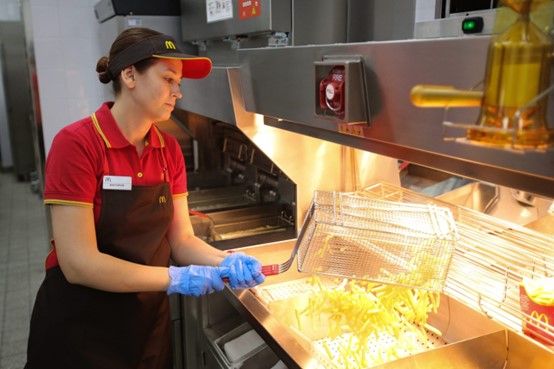
事實(shí)證明,快餐消費(fèi)者并不想要薯?xiàng)l。隨著越來越多顧客因?yàn)楦甙旱膬r(jià)格對(duì)快餐失去了興趣,,北美最大的薯?xiàng)l生產(chǎn)商因?yàn)槭袌?chǎng)放緩而陷入困境。
藍(lán)威斯頓(Lamb Weston)僅一家工廠每年生產(chǎn)的冷凍土豆制品就高達(dá)2.5億磅,。本月早些時(shí)候,,該公司宣布將裁員4%(約428名工人),并關(guān)閉位于華盛頓州康奈爾的工廠,。自今年年初以來,,該公司的股價(jià)已暴跌約33%。
藍(lán)威斯頓的發(fā)言人對(duì)《財(cái)富》雜志表示,,此次關(guān)閉的是一家較為老舊的工廠,,僅占公司產(chǎn)能的5%。
藍(lán)威斯頓CEO湯姆·沃納在10月1日的業(yè)績電話會(huì)議上表示,,快餐漢堡連鎖餐廳是導(dǎo)致公司業(yè)績下滑的罪魁禍?zhǔn)?。在藍(lán)威斯頓的第一季度,這些餐廳的客流量下降了3%,,客流量同比整體下滑了2%,。沃納預(yù)計(jì),2025財(cái)年,,客流量將繼續(xù)下滑,。
麥當(dāng)勞(McDonald’s)是藍(lán)威斯頓的最大客戶,貢獻(xiàn)了公司13%的銷售額,。這家土豆加工公司還為百勝餐飲集團(tuán)(Yum Brands)(旗下有肯德基(KFC)和塔可鐘(Taco Bell)等品牌)生產(chǎn)薯?xiàng)l,。
菜單價(jià)格上漲使得快餐對(duì)于許多消費(fèi)者來說變成了奢侈品,,這意味著麥當(dāng)勞和溫迪快餐廳(Wendy’s)等行業(yè)巨頭難以吸引消費(fèi)者,更不用說讓人們大手大腳地消費(fèi),。上個(gè)季度,,麥當(dāng)勞的同店銷售額下降了1%,而百勝餐飲第二季度的收入同比上漲了4.5%,,但由于銷售令人失望,,因此未能達(dá)到預(yù)期。
麥當(dāng)勞美國總裁喬·厄林格7月份對(duì)投資者表示:“歸根結(jié)底,,我們預(yù)計(jì)在競(jìng)爭(zhēng)高度激烈的大環(huán)境下,,至少在未來幾個(gè)季度,消費(fèi)者將繼續(xù)感受到經(jīng)濟(jì)和生活成本上升帶來的壓力,?!?/p>
炸薯?xiàng)l作為經(jīng)濟(jì)指標(biāo)
沃納認(rèn)為,薯?xiàng)l銷售情況通常是體現(xiàn)經(jīng)濟(jì)健康狀況的良好指標(biāo),。薯?xiàng)l通常是快餐中消費(fèi)最多的配菜之一,,當(dāng)消費(fèi)者感到手頭拮據(jù)時(shí),往往會(huì)取消薯?xiàng)l,。但在經(jīng)濟(jì)狀況良好時(shí),,薯?xiàng)l是顧客首先會(huì)添加到訂單中的配菜。沃納在去年十月接受CNBC采訪時(shí),,將這種情況稱之為“薯?xiàng)l加購率”。
盡管在2022年,,薯?xiàng)l加購率實(shí)際上從疫情之前的22%提高到24%,,但在快餐行業(yè)適應(yīng)艱難環(huán)境的過程中,藍(lán)威斯頓仍在苦苦掙扎,。麥當(dāng)勞CEO克里斯·坎普欽斯基在2月份承認(rèn),,越來越多的消費(fèi)者為了節(jié)省開支,選擇在家做飯,。這不僅對(duì)麥當(dāng)勞來說是個(gè)壞消息,,對(duì)藍(lán)威斯頓也是個(gè)麻煩,因?yàn)樵摴颈硎?,美國消費(fèi)的所有冷凍薯?xiàng)l產(chǎn)品中有80%來自快餐廳,。
快餐行業(yè)的增速放緩還引發(fā)了價(jià)值戰(zhàn),快餐廳推出了促銷套餐以吸引顧客回流,,包括麥當(dāng)勞的5美元套餐和溫迪的3美元雙人早餐套餐,。但是,盡管這些促銷措施幫助增加了店內(nèi)客流量,,卻對(duì)藍(lán)威斯頓幫助不大,,因?yàn)椴蛷d顧客并不熱衷于升級(jí)到更大份的薯?xiàng)l,。
沃納表示:“值得注意的是,許多這些促銷套餐讓消費(fèi)者將薯?xiàng)l從中份換成了小份,?!?/p>
然而,對(duì)藍(lán)威斯頓來說還有一線希望,。沃納表示,,除了在困難時(shí)期維持與餐廳的合作外,該公司在上個(gè)季度還擴(kuò)大了與其他連鎖店的業(yè)務(wù),。
哥倫比亞商學(xué)院(Columbia Business School)的食品和餐廳顧問斯蒂芬·扎戈?duì)柋硎?,至少?duì)于麥當(dāng)勞來說,特別是隨著通脹的降溫,,快餐業(yè)的放緩將是短暫的,。
他在7月份對(duì)《財(cái)富》雜志表示:“這將是短暫的波動(dòng)。消費(fèi)者終將回歸,。他們總是會(huì)恢復(fù)快餐消費(fèi),。”
麥當(dāng)勞和百勝餐飲均未回應(yīng)《財(cái)富》雜志的置評(píng)請(qǐng)求,。(財(cái)富中文網(wǎng))
譯者:劉進(jìn)龍
審校:汪皓
事實(shí)證明,,快餐消費(fèi)者并不想要薯?xiàng)l。隨著越來越多顧客因?yàn)楦甙旱膬r(jià)格對(duì)快餐失去了興趣,,北美最大的薯?xiàng)l生產(chǎn)商因?yàn)槭袌?chǎng)放緩而陷入困境,。
藍(lán)威斯頓(Lamb Weston)僅一家工廠每年生產(chǎn)的冷凍土豆制品就高達(dá)2.5億磅。本月早些時(shí)候,,該公司宣布將裁員4%(約428名工人),,并關(guān)閉位于華盛頓州康奈爾的工廠。自今年年初以來,,該公司的股價(jià)已暴跌約33%,。
藍(lán)威斯頓的發(fā)言人對(duì)《財(cái)富》雜志表示,此次關(guān)閉的是一家較為老舊的工廠,,僅占公司產(chǎn)能的5%,。
藍(lán)威斯頓CEO湯姆·沃納在10月1日的業(yè)績電話會(huì)議上表示,快餐漢堡連鎖餐廳是導(dǎo)致公司業(yè)績下滑的罪魁禍?zhǔn)?。在藍(lán)威斯頓的第一季度,,這些餐廳的客流量下降了3%,客流量同比整體下滑了2%,。沃納預(yù)計(jì),,2025財(cái)年,客流量將繼續(xù)下滑,。
麥當(dāng)勞(McDonald’s)是藍(lán)威斯頓的最大客戶,,貢獻(xiàn)了公司13%的銷售額,。這家土豆加工公司還為百勝餐飲集團(tuán)(Yum Brands)(旗下有肯德基(KFC)和塔可鐘(Taco Bell)等品牌)生產(chǎn)薯?xiàng)l。
菜單價(jià)格上漲使得快餐對(duì)于許多消費(fèi)者來說變成了奢侈品,,這意味著麥當(dāng)勞和溫迪快餐廳(Wendy’s)等行業(yè)巨頭難以吸引消費(fèi)者,,更不用說讓人們大手大腳地消費(fèi)。上個(gè)季度,,麥當(dāng)勞的同店銷售額下降了1%,,而百勝餐飲第二季度的收入同比上漲了4.5%,但由于銷售令人失望,,因此未能達(dá)到預(yù)期,。
麥當(dāng)勞美國總裁喬·厄林格7月份對(duì)投資者表示:“歸根結(jié)底,我們預(yù)計(jì)在競(jìng)爭(zhēng)高度激烈的大環(huán)境下,,至少在未來幾個(gè)季度,,消費(fèi)者將繼續(xù)感受到經(jīng)濟(jì)和生活成本上升帶來的壓力?!?/p>
炸薯?xiàng)l作為經(jīng)濟(jì)指標(biāo)
沃納認(rèn)為,,薯?xiàng)l銷售情況通常是體現(xiàn)經(jīng)濟(jì)健康狀況的良好指標(biāo)。薯?xiàng)l通常是快餐中消費(fèi)最多的配菜之一,,當(dāng)消費(fèi)者感到手頭拮據(jù)時(shí),,往往會(huì)取消薯?xiàng)l。但在經(jīng)濟(jì)狀況良好時(shí),,薯?xiàng)l是顧客首先會(huì)添加到訂單中的配菜,。沃納在去年十月接受CNBC采訪時(shí),將這種情況稱之為“薯?xiàng)l加購率”,。
盡管在2022年,,薯?xiàng)l加購率實(shí)際上從疫情之前的22%提高到24%,但在快餐行業(yè)適應(yīng)艱難環(huán)境的過程中,,藍(lán)威斯頓仍在苦苦掙扎。麥當(dāng)勞CEO克里斯·坎普欽斯基在2月份承認(rèn),,越來越多的消費(fèi)者為了節(jié)省開支,,選擇在家做飯。這不僅對(duì)麥當(dāng)勞來說是個(gè)壞消息,,對(duì)藍(lán)威斯頓也是個(gè)麻煩,,因?yàn)樵摴颈硎荆绹M(fèi)的所有冷凍薯?xiàng)l產(chǎn)品中有80%來自快餐廳,。
快餐行業(yè)的增速放緩還引發(fā)了價(jià)值戰(zhàn),,快餐廳推出了促銷套餐以吸引顧客回流,包括麥當(dāng)勞的5美元套餐和溫迪的3美元雙人早餐套餐,。但是,,盡管這些促銷措施幫助增加了店內(nèi)客流量,,卻對(duì)藍(lán)威斯頓幫助不大,因?yàn)椴蛷d顧客并不熱衷于升級(jí)到更大份的薯?xiàng)l,。
沃納表示:“值得注意的是,,許多這些促銷套餐讓消費(fèi)者將薯?xiàng)l從中份換成了小份?!?/p>
然而,,對(duì)藍(lán)威斯頓來說還有一線希望。沃納表示,,除了在困難時(shí)期維持與餐廳的合作外,,該公司在上個(gè)季度還擴(kuò)大了與其他連鎖店的業(yè)務(wù)。
哥倫比亞商學(xué)院(Columbia Business School)的食品和餐廳顧問斯蒂芬·扎戈?duì)柋硎?,至少?duì)于麥當(dāng)勞來說,,特別是隨著通脹的降溫,快餐業(yè)的放緩將是短暫的,。
他在7月份對(duì)《財(cái)富》雜志表示:“這將是短暫的波動(dòng),。消費(fèi)者終將回歸。他們總是會(huì)恢復(fù)快餐消費(fèi),?!?/p>
麥當(dāng)勞和百勝餐飲均未回應(yīng)《財(cái)富》雜志的置評(píng)請(qǐng)求。(財(cái)富中文網(wǎng))
譯者:劉進(jìn)龍
審校:汪皓
It turns out that, no, fast-food eaters would not like fries with that. As more customers lose their appetite for fast food over sky-high prices, North America’s largest fry producer is reeling from the slowdown.
Lamb Weston, which can churn out 250 million pounds of frozen potato products annually at just one facility, announced earlier this month that it would lay off 4% of its workforce (about 428 workers) and shut down its Connell, Wash., production plant. Since the beginning of the year, its share price has plummeted by about 33%.
A Lamb Weston spokesperson told Fortune the closed plant was an older facility representing only 5% of the company’s capacity.
CEO Tom Werner said on an Oct. 1 earnings call that quick-service burger chains in particular are to blame for Lamb Weston’s slump. Traffic at those restaurants decreased 3% in the company’s first quarter, while restaurant traffic overall slumped 2% year over-year. Werner expects traffic to continue to falter through fiscal 2025.
McDonald’s is Lamb Weston’s largest customer, accounting for 13% of its sales. The potato processor also produces fries for Yum Brands, which owns KFC and Taco Bell.
Menu price inflation has turned fast food into a luxury for many consumers, meaning industry titans like McDonald’s and Wendy’s have struggled to attract consumers, let alone get them to splurge. McDonald’s same-store sales shrank 1% last quarter, and while Yum Brands reported a 4.5% bump in year-over-year revenue for its second quarter, it fell short of expectations due to disappointing sales.
“At the end of the day, we expect customers will continue to feel the pinch of the economy and a higher cost of living for at least the next several quarters in this very competitive landscape,” McDonald’s U.S. President Joe Erlinger told investors in July.
French fries as an economic indicator
Werner argues that french fry sales are generally a good indicator of economic health. They are usually one of the more expendable fast-food side items and are nixed from orders when consumers feel penny-pinched. But during healthy economic times, they’re the first side that customers add to their order. Werner called this the “fry attachment rate” in a CNBC interview last October.
Despite the fry attachment rate actually increasing to 24% in 2022, compared to 22% before the pandemic, Lamb Weston has continued to struggle as the fast-food industry adapts to a difficult environment. McDonald’s CEO Chris Kempczinski acknowledged in February more consumers are turning to home-cooked meals to save money. Beyond that being bad news for McDonald’s, it’s also trouble for Lamb Weston, which said that 80% of all frozen fries products consumed in the U.S. comes from fast-food restaurants.
The fast-food industry slowdown has also sparked a value war and the introduction of promotional meal deals to lure back customers, including the McDonald’s $5 meal deal and the Wendy’s two-for-$3 breakfast deal. But while such enticements have helped increase store traffic, the promotions haven’t been of much help to Lamb Weston, as restaurant visitors aren’t eager to upgrade to larger fry sizes.
“It’s important to note that many of these promotional meal deals have consumers trading down from a medium fry to a small fry,” Werner said.
There’s a silver lining for Lamb Weston, however. Werner said that in addition to maintaining its restaurant partners during the difficult stretch, the company also expanded business with other chains this past quarter.
Stephen Zagor, a food and restaurant consultant who teaches at Columbia Business School, said the fast-food slowdown, at least for McDonald’s, will be short-lived, particularly as inflation cools.
“It’s going to be a blip,” he told Fortune in July. “They’re going to come back. They always come back.”
McDonald’s and Yum Brands did not respond to Fortune’s request for comment.






